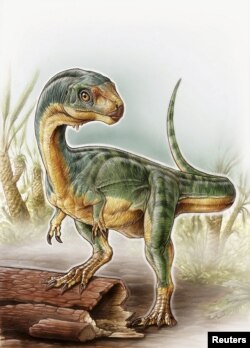Scientists have unearthed fossils of a strange dinosaur in southern Chile with such an unusual combination of traits that they are comparing it to a platypus, that oddball egg-laying, duck-billed mammal from Australia.
Named Chilesaurus diegosuarezi, it is a member of the theropods, the group that includes Tyrannosaurus rex. The theropods included the largest land meat-eaters in Earth's history, but Chilesaurus diegosuarezi ate only plants, with a beak and leaf-shaped teeth, scientists said this week.
Its skull and neck resembled those of long-necked dinosaurs, and its vertebrae were like those of meat-eating theropods. It had robust arms, but just two blunt fingers on each hand. It was bipedal, but its wide, four-toed feet were unlike the slender, three-toed feet of most theropods. And it had a birdlike pelvis.
"Chilesaurus constitutes one of the most bizarre dinosaurs ever found," said paleontologist Fernando Novas of the Bernardino Rivadavia Natural Sciences Museum in Buenos Aires, calling the creature an evolutionary "jigsaw puzzle."
"The skeletal anatomy of Chilesaurus gathers characteristics of different dinosaur groups, like a floor is composed of mosaics of different shapes and colors," he said. "No other dinosaurs exhibit such a combination or mixture of features."
Chilesaurus lived in a region crisscrossed by rivers at the Jurassic Period's end, approximately 145 million years ago. It was relatively small, reaching up to 10.5 feet (3.2 meters) long, although most specimens found were more the size of a turkey.
It belongs to a previously unknown dinosaur lineage, University of Birmingham paleontologist Martín Ezcurra said.
"The most interesting [aspect] about Chilesaurus is the story that it tells about how evolution works," he said.
" 'Convergent evolution' is a process in which two unrelated species or groups acquire similar characteristics from living in similar environments or having a similar behavior," like the wings of a bat and a bird, Ezcurra added. "In the case of 'mosaic convergent evolution,' different parts of the body resemble those of other unrelated species, such as in the case of the platypus and Chilesaurus."
Most theropods were meat-eaters, although a few lineages preferred salad over steak. Chilesaurus diegosuarezi, whose name honors the country where it was unearthed and the 7-year-old who spotted the first fossils, is the first known Southern Hemisphere herbivorous theropod.
Four nearly complete skeletons and dozens of bones from other individuals were found, making Chilesaurus one of the best understood Jurassic Southern Hemisphere dinosaurs.
The research appears in the journal Nature.
